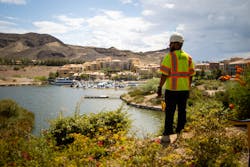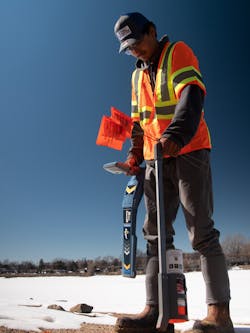The days of underground communication lines being less critical are over. It was on its way, but the pandemic turned this statement into a standard. A decade ago, communication service interruption was not much more than an inconvenience. A damaged coax cable or phone line certainly wasn’t on most people’s radar as a critical issue (unless of course, it was a damaged CATV line on Football Saturday). Today is a different and more connected world, though. For many households, if the communication line is damaged it means there’s no working from home, no learning from home, and no entertainment at home. In an even more connected household, a damaged communication line could impact home security, the thermostat, and even the refrigerator. The days of losing just entertainment and experiencing a relatively minor inconvenience are over.
“The Common Ground Alliance notes in their Next Practices Initiative that ‘Underinvesting in safety at the beginning of a project leads to overpaying in damages.’ Of course, there is the cost to replace/repair, but there is also risk to the bottom line through loss of customers.”
The underground communications infrastructure is the unseen framework of connectivity. That means this critical network is at risk of being damaged anytime a homeowner, professional excavator, or even the utilities themselves are digging or “moving the earth”. The message of 811, “Call Before You Dig”, is spread far and wide because calling or clicking before you dig is the first step to protecting that connectivity. Each state has an 811 system which processes millions of tickets each year that essentially warns facility owners, “we are going to dig, and your facilities will be at risk.”
The importance of calling 811 before digging is primarily to protect public safety and our vital subsurface infrastructure by sending notices of proposed excavation to a utility locate company. The utility locate technicians review the work order, assess the risk, identify the at-risk facilities, and mark the ground where a conflict may exist. In the case of communications, a locate technician paints orange marks on the ground signifying to any excavator that communication lines exist there and to help them avoid hitting the line. Though these are state guidelines all should follow, there’s still much work to be done. In fact, there were a reported 193K damages to communication facilities according to Common Ground Alliance’s (CGA) 2020 DIRT report1, which is a staggering number.
The process is relatively straightforward. Excavators have the job to excavate safely and not hit a utility line. The Department of Labor’s Occupational Safety & Health Administration (OSHA) lays the groundwork for this in their “Trenching and Excavation Safety” guide2 by outlining excavation standards before even starting excavation. Their piece of the process is to call 811 to get a ticket for the area, and have the utility located all before the excavation. The next step is to follow state guidelines when performing the excavation, respect the marks, and excavate safely around those marked facilities.
Unfortunately, the process doesn’t always work.
There is a shared responsibility when it comes to underground damage prevention. This is the reason for the existence of CGA’s “Best Practices” manual3, which is an agreed upon document by 16 industry stakeholder groups including excavators, contract utility locators, local government officials, developers and more. All have the intention to improve worker safety and protect the underground infrastructure. Previously, the most at-risk facilities would have been the gas or electric lines because they could cause immediate injuries. While there is still an immediate danger associated with electric and gas lines, homeowners are becoming more acutely aware of what they lose when a communication line is damaged.
Reliability in service is not just critical for homeowners, but also for businesses and emergency services. Imagine trying to call 911 in an emergency, but not being able to reach them because a fiber optic cable was damaged during excavation. Sure, most damages are restored in a reasonable amount of time, however, it still disrupts the service. Recently, a communications company was interrogated by their state’s corporation commission regarding a service outage investigation. The investigation4 could connect at least one death to the outage, which affected 911 services and hospitals in the area. The investigation could result in a court order for the company to justify its damage prevention practices.
Damage Prevention = ESG Commitment
Connectivity is not going away. In fact, reliance on technology is only going to increase. The Biden-Harris Administration just started the “Internet for All” initiative. The focus of this program is bringing high-speed Internet to rural areas that previously didn’t have the money or infrastructure before. This program is putting $65 billion into expanding Internet access. The “Internet for All” website5 says “High-speed Internet doesn’t just help individuals. It helps our country.” From this standpoint alone, communication companies can consider damage prevention as part of their environmental, social, and governance program.
Stake Center Locating’s Chief Operating Officer and Chief Financial Officer, Heath Martin, said it best “The stakes are getting higher as the importance of connectivity has grown exponentially. Decades ago, an interruption in service was an inconvenience. With the amount of data being processed today, an interruption in service can be critical to homes and businesses.” All of this means communication is more important now than ever, so now more than ever there is a need to protect our critical communications infrastructure.
Damage prevention is not a one-size-fits-all, but one industry segment who has made continual investments in damage prevention and seen successful results is the gas and oil industry. The gas and oil industry approaches damage prevention in many ways—everything from investing in Dedicated Locating Services (where a locating firm locates for one utility locating company only), enhancing communication with operators and excavators to partnering in public education. There are continual efforts to collect data and improve programs. They also contract utility locating companies who focus on superior quality to be sure highly trained technicians focus their attention on locating their critical infrastructure for excavators.
The time is now for communication companies to make an investment in damage prevention. Not only is there the public aspect, but there is also the cost. The CGA notes in their Next Practices Initiative6 that “Underinvesting in safety at the beginning of a project leads to overpaying in damages.” Of course, there is the cost to replace/repair, but there is also risk to the bottom line through loss of customers. As homeowners are getting privier to the process, they’re also noticing communication competitors. They know their need for connectivity is important, so they need to select the company that gives them the reliable service.
It’s undeniable that there’s a growth of connectivity, of communication. What is below ground directly effects the communication aboveground. With more money and installation belowground, comes the need to protect it. Without it we lose the way we live, the way we do business, and the way we connect with the world. The need for communication companies to make investments in damage prevention, and implement preventative actions and programs, is higher than it’s ever been. The sooner that’s understood, the sooner that piece of critical underground communications infrastructure can stay intact, and life can flourish.
REFERENCES AND NOTES
1. CGA (2020). Damage Information Reporting Tool – 2020 Analysis & Recommendations, https://commongroundalliance.com/Portals/0/2020%20DIRT%20Report_09.29.2021_Final4.pdf?ver=2021-11-03-143123-490
2. U.S. Department of Labor, OSHA. Trenching and Excavation Safety guide, https://www.osha.gov/sites/default/files/publications/osha2226.pdf
3. CGA (2021, June). Best Practices: The Definitive Guide for Underground Safety & Damage Prevention, https://bestpractices.commongroundalliance.com/#mainContentAnchor
4. Latch, L., Arizona Republic (2022, June 28). Utility Regulators Grill Frontier Communications About Service Outage in Northern Arizona, https://www.azcentral.com/story/news/local/arizona/2022/06/28/corp-comm-grills-frontier-communications-over-911-outage/7760611001/
5. Internet for All (2022). Why Internet Matters, https://www.internet4all.gov/why
6. CGA (2021, October). Next Practices Initiative – Pathways to Improving U.S. Damage Prevention, https://commongroundalliance.com/Portals/0/Next%20practices%20Pathways%20Report%202021_FINAL4.pdf?ver=2021-10-12-180926-957
ABOUT THE AUTHOR
Ashley Zolot is Marketing Manager, Stake Center Locating. She has experience in Marketing and Public Relations. For more information, visit www.stakecenter.com. Follow Ashley on LinkedIn: in/ashleyzolot/. Follow Stake Center Locating on Twitter @center_stake, LinkedIn: company/stake-center-locating, Instagram: stake_center_locating, and Facebook: StakeCenter.
About the Author
Ashley Zolot
Marketing Manager, Stake Center Locating
Ashley Zolot is Marketing Manager, Stake Center Locating. She has experience in Marketing and Public Relations. For more information, visit www.stakecenter.com. Follow Ashley on LinkedIn: in/ashleyzolot/. Follow Stake Center Locating on Twitter @center_stake, LinkedIn: company/stake-center-locating, Instagram: stake_center_locating, and Facebook: StakeCenter.

